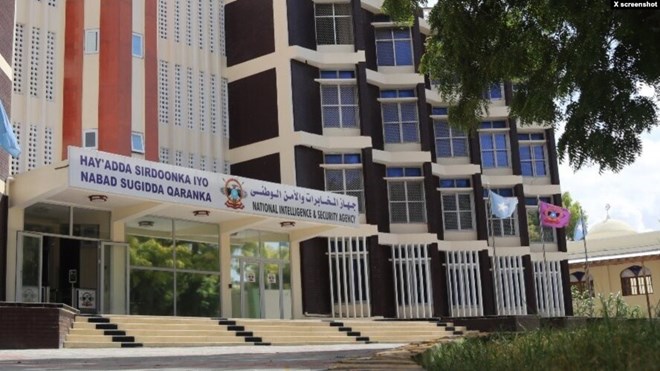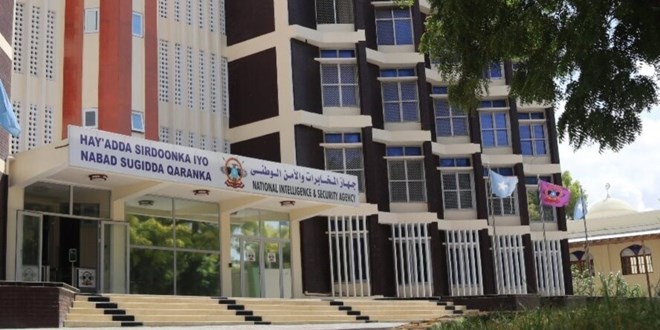[ad_1]

Thursday March 14, 2024
By Harun Maruf

The headquarters of Somalia’s National Intelligence and Security Agency in Mogadishu. Government officials have confirmed there are dedicated teams at the agency that alert tech companies for removal of extremist content being posted by al-Shabab.
Websites and social media accounts affiliated with Somalia’s al-Shabab militants continue to operate and spread the group’s messages despite a relentless effort by Somalia’s government to shut them down.
At least two such websites that were recently closed were quickly back up and running after being re-registered and securing new domains. Also operating are al-Shabab affiliated social media accounts, mainly on Telegram and Facebook, that constantly re-emerge as soon as recognized accounts are closed.
Meanwhile, al-Shabab’s two main radio outlets continue to broadcast in Somalia.
The Somali government has within the last year and half prioritized curtailing al-Shabab’s online media presence to reduce the group’s reach and influence.
Government officials have confirmed to VOA for the first time that there are dedicated teams at Somalia’s National Intelligence and Security Agency, or NISA, that monitor and alert tech companies for removal of extremist content.
“It was a difficult task when we started, it needed knowledge, skills and a lot of work,” says Deputy Information Minister Abdirahman Yusuf al-Adala. “We trained people with the necessary skills, special offices have been set up, equipment has been made available, and legislation has been passed by the parliament. More than a year later, we are in a good position, we believe we have achieved many of our targets.”
Al-Adala says he believes removing known accounts that had thousands of followers is a significant achievement.
VOA learned from security sources that on Dec. 26, 2023, the Somali government secured a court order to shut down and seize the domains of websites and social media accounts suspected to have been owned by, used by or affiliated with al-Shabab.
At the end of January, the government reported it shut down 20 WhatsApp groups and 16 websites allegedly affiliated with the U.S.-designated terrorist organization.
The Somali government said the groups and websites violated “all international counter terrorism legislations,” and posed an “imminent threat to both national and international security.”
The move did not come without protest. One website that was shut down, Somalimemo, says it is an independent news site and serves the Somali people, and has no affiliation with any organization, group, government or any other political side.
Somalimemo, which has regularly published al-Shabab statements and speeches, criticized what it characterized as the Somali government’s attempts to target “Islamic media.”
An al-Shabab radio affiliate, Al-Furqaan, which operates in areas controlled by al-Shabab, said it did not receive a notification from NISA before its websites were shut down. It said the move contradicts the government’s official position that it respects freedom of media. Al-Furqaan has continued its radio broadcasts.
The shutdowns have not stopped al-Shabab from disseminating its messages. After the January closures, the group’s media workers quickly adapted, creating new social media accounts and tweaking domain names to get back online.
Al-Shabab adapts
Mohamed Gulaid is an internet trust and safety researcher and member of the Integrity Institute who worked previously with Facebook’s parent company, Meta. He says al-Shabab and similar extremist groups employ various tactics to avoid government crackdowns and stay online.
“These strategies include using long multimedia content (video, audio) in Somali,” he said. “Content moderation tools often struggle with long-form content and languages like Somali due to limited training data.”
Gulaid said al-Shabab also makes heavy use of platforms like WhatsApp and Telegram, where moderation is difficult because of encryption and depends on reporting from trusted partners and more manual investigations.
“The last strategy for al-Shabab is to open many anonymous accounts where they post links to videos posted on other websites that don’t have content moderation or their own websites,” he said.
Adam Hadley is the executive director of Tech Against Terrorism, a non-profit based in London that focuses on disrupting the use of the internet by terrorist groups.
He says al-Shabab is one of the most sophisticated actors in terms of the ways that it uses the internet to share its material.
“In any given week, around 20 to 25% of the content we find on the internet has likely been created by al-Shabab,” he said. “It’s essentially the largest single producer of terrorist material on the internet.”
Disinformation
The government said apart from publishing al-Shabab ideology, the websites spread misinformation and disinformation by misrepresenting the views of the Somali government, claiming the country is under attack from “crusaders,” and slandering the government as “apostate” even though Somalia’s constitution is based on Islamic law.
“Al-Shabab consistently engages in misinformation, often exaggerating their operational impact and overstating their influence or control,” Gulaid said.
“When it comes to disinformation, al-Shabab often manipulates broader themes such as nationalism and the lack of service delivery by the Somali government to further their agenda. They portray themselves as more effective and a nationalist force safeguarding Somalia’s sovereignty.”
Defectors say al-Shabab spends a lot of money translating these messages into English, Arabic, Swahili and Amharic.
Hadley says another al-Shabab tactic is to share so-called “news material” related to the group but obscured as generic news activity and news articles on various websites.
“Much of this content is quite subtle and nuanced, and it takes quite a lot of time to establish that this type of material is in fact misinformation or fake news,” he said.
“In one particular case, we found an entire news website that had a suspicious concentration of material that there was pro al-Shabab and pro al-Qaida. … At no point did we find any obvious graphic or violent material on this site. It was almost pretending to provide a news service.”
He says convincing platform companies to remove the materials can take months. He warns that the effort also requires careful analysis and investigation to avoid the risk that legitimate political speech could be affected.
Contacted by VOA, a spokesperson for Meta sent a brief statement, saying “We do not allow terrorist groups on our platforms, so we ban al-Shabaab accounts.”
Meta also said under its Dangerous Organizations and Individuals policy, it removes content that glorifies, supports, or represents such people and groups whenever the company becomes aware of it.
[ad_2]
